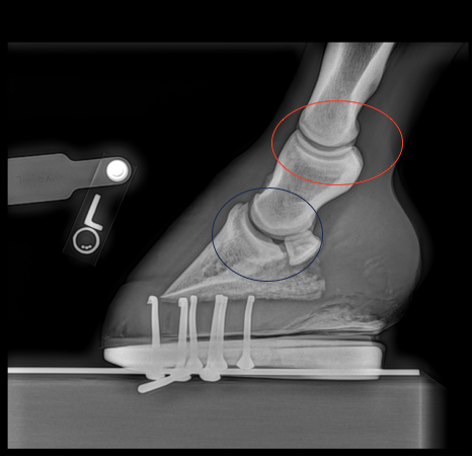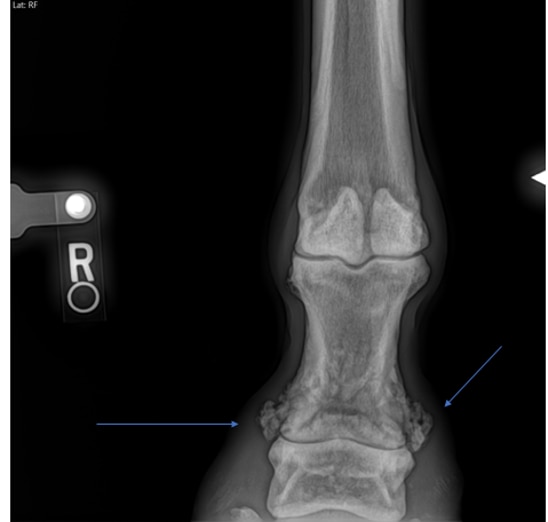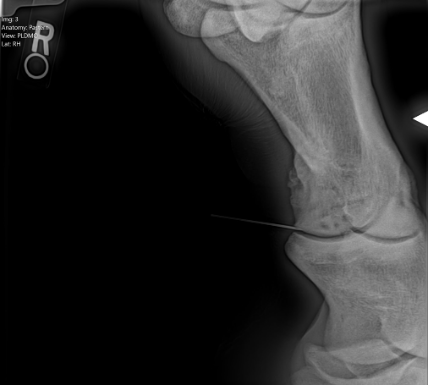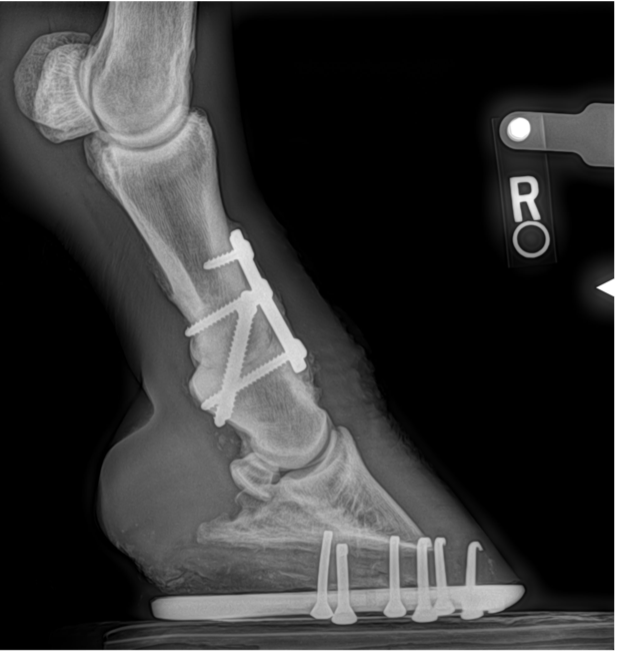Ringbone in Horses: Causes, Symptoms, and Management
Brastock Images/iStock / Getty Images Plus via Getty Images
Ringbone in horses refers to arthritis of the pastern and coffin joints and is a common problem in many athletic horses.
Key Takeaways
- Ringbone is arthritis in or around the pastern or coffin joint in the horse.
- It can cause significant lameness and pain at any gait, and is typically diagnosed with a lameness exam and X-rays.
- Treatments for ringbone can include anti-inflammatory medications, joint health medications, supplements, joint injections, or surgery.
What Is Ringbone in Horses?
Ringbone in horses can be separated into two categories:
-
High ringbone: Arthritis in the proximal interphalangeal joint (pastern), which is the joint between the long and short pastern bones
-
Low ringbone: Arthritis in the distal interphalangeal joint (coffin joint), which is the joint between the short pastern bone and the coffin bone (inside the foot)

A horse may limp due to discomfort on a leg affected by ringbone, sometimes severe enough they have a notable head bob or dip in their pelvic area. In some horses, there may be a visible bony protrusion over the joint.
Ringbone is very common in athletic and competitive middle-aged horses. It is less common in younger horses.
Horses that have issues with conformation , the natural build of their bodies, are more prone to ringbone. These issues may include:
-
Upright pasterns
-
Pigeon toes (toe-in)
-
Small feet
-
Low palmar angles (the angle the bottom of the pedal bone makes with the ground)

Although ringbone can cause discomfort, it is not considered a medical emergency. Ringbone is commonly slow-forming and can start as minor discomfort and lead to a more significant lameness.
If you suspect any type of lameness, including that due to ringbone, contact your veterinarian to examine your horse.
Symptoms of Ringbone in Horses
Common symptoms of ringbone in horses may be slow to develop. These signs include:
-
Lameness/limping
-
Stiffness in movement
-
Visible bump on the pastern or above the coronary band
Causes of Ringbone in Horses
Essentially, ringbone in horses is a type of arthritis. Arthritis is the progressive wearing out of cartilage in a joint, and this leads to rough bone surface and building of more bone. This “new” bone is what we know as arthritis and bone spurs.
Arthritis in horses can result from:
-
Abnormal development
-
Rapid growth
-
Infection
-
Injury
-
Long-term wear and tear on the joint
-
Environmental conditions such as poor footing or working on hard surfaces
In a normal joint, cartilage covers the bone and protects it, creating a soft gliding surface between the two ends of the bone. In a joint affected by arthritis, that cartilage has been worn down or even completely ruined, leading to the two bones rubbing together and creating a rough surface.
This constant grinding on an uneven or jagged surface causes pain and inflammation. Unfortunately, cartilage cannot be replaced, so the body tries to rebuild with bone, creating rougher surface and bone spurs.
Equine ringbone is when the pastern bones or pastern and coffin bones have developed this rough surface.
How Veterinarians Diagnose Ringbone in Horses
History
A complete history from the owner can be vital information to help with a diagnosis. This includes:
-
When the limp started, which leg, and how long it has been a problem
-
Previous injuries
-
Old wounds
-
Medical history
-
Long-term hoof problems
-
Growth issues in young horses
Lameness Exam
Veterinarians start physical diagnosis with a baseline lameness exam, where they watch the horse trot in hand with a lead rope on a hard surface. Then they will watch the horse trot and canter/lope in circles on both hard and soft ground, working on a lunge line.
Flexion Testing
A flexion test of the limbs should be performed to assess the horse’s response. Flexion is when the veterinarian will flex a particular joint, then watch the horse immediately trot away. If a joint is abnormal, the stress caused by the flexion leads to a pain response or a limp when the horse trots away.
Block Testing
Blocks can be performed as well, allowing a vet to narrow down the area causing the pain. A block is a procedure where a numbing agent, similar to an agent the dentist uses on your mouth, is injected in a certain area. This will numb specific sections of the leg; if the horse is no longer sore after blocking, that area is where the pain is coming from.
X-Rays
After the thorough lameness exam the veterinarian will likely take X-rays to evaluate the joints. The X-rays may show arthritic change in the coffin or pastern joint and allow diagnosis of high or low ringbone.
Treatment for Ringbone in Horses
Unfortunately, there is no treatment for ringbone in horses because it is incurable. Once the arthritis has begun, the damage cannot be reversed; it can, however, be managed to slow progression and increase the horse’s comfort.
Options for equine ringbone management include:
-
Systemic injectable joint medications to decrease pain, improve comfort, and benefit any arthritic joint
-
Joint injections (medications dosed directly into the joint by your vet) to help improve the joint environment and comfort
-
Joint supplements for daily support
-
Therapeutic shoeing to shorten the toe and easing breakover, allowing the horse to place minimal pressure on the joints affected.
-
Surgical arthrodesis to fuse the joint, limiting movement and decreasing discomfort.


Management of Ringbone in Horses
Each therapy has timelines for maximum effect, and they can vary from hors to horse.
In most horses, therapeutic shoeing has visible results within a week. Intra-articular joint injections typically show results within two weeks. Anti-inflammatory medications may show results in as little as 24 hours. If surgery is performed, it can be months to a year for recovery.
Prognosis for horses with ringbone is guarded for full recovery and soundness, however it can be managed.
Common medications that may be prescribed to manage pain include:
Intra-articular joint injections can be performed by your veterinarian at intervals they feel are appropriate for your horse.
Prevention of Ringbone in Horses
Prevention of ringbone is narrowed to the factors that people can control. Since we cannot change the way a horse is built, the best we can do is minimize risk by:
-
Maintaining a strict shoeing schedule on horses with at-risk conformation flaws
-
Conditioning and fitness in competitive horses to minimize injury
-
Using protective/supportive boots or wraps during competition
Ringbone in Horses FAQs
What are the first signs of ringbone in horses?
The first signs are typically lameness and discomfort in your horse, particularly when they are in motion.
Can a horse with ringbone be ridden?
Horses with low-grade lameness as a result of ringbone can be maintained and ridden. Moderate ringbone can be maintained for comfort and horses may be ridden at a lower activity level. Severe ringbone can cause significant lameness and these horses are typically retired.
How long can horses live with ringbone?
Depending on the severity, a horse can live with ringbone for years.
What is false ringbone in horses?
False ringbone is when there is arthritic change outside the joint along the pastern bone, rather than directly involving the joint. It typically has symptoms similar to high and low ringbone, but it is not technically ringbone because it is not inside the joint.
How does corrective shoeing help ringbone?
Corrective shoeing balances the foot, decreasing the stress on the joints themselves to minimize injury and discomfort.
Can ringbone in horses be reversed?
Ringbone cannot be reversed. Arthritis is permanent, but it can be maintained to slow progression and maximize comfort.
